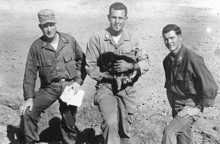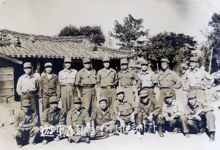| 8240th Army Unit | |
|---|---|
| Active | July 1951–November 1952 |
| Allegiance | |
| Role |
Guerrilla Warfare Special operations |
| Size | 100 [1] |
| Commanders | |
| Unit Commander | Captain Donald Seibert |
The 8240th Army Unit (8240th AU) was an American guerrilla unit that operated during the Korean War. It of US Army advisors who mainly trained South Korean partisans for operations in North Korea.
History
One of the 8240th Army Unit's predecessors was the Korea Liaison Office (KLO), which operated from 1949 to 1951. In July 1951, the KLO was incorporated into the 8240th Army Unit.

The 8240th AU, led by Captain Donald Seibert, focused on training South Korean troops and guerrilla warfare. Operations included dropping airborne guerilla forces far behind enemy lines, as well as training North Korean refugees to gather intelligence by posing as North Korean soldiers. [2]
In November 1952, the unit, along with other guerrilla units, was redesignated as United Nations Partisan Forces Korea. [3]
Units
There were 22 Donkey Units (Donkey-4 also known as White Tigers) and 8 Wolfpack units.
Guerrilla activities
The Eighth Army took the guerrilla fighters and organized them into the "Donkey" squads in early 1951. [4] These squads were organized on islands that, luckily, was a strategic advantage. The islands were behind enemy lines but were protected by the UN naval blockade and ROK garrisons from any enemy attack. There were five main activities that happened on these islands:
- Leopard Base
- Wolfpack
- Kirkland
- Baker Section
- Tactical Liaison Office
Leopard Base
Operating from the Yalu River south of the Ongin Peninsula, Leopard Base (originally part of "Task Force William Able" [5]) was the headquarters for 11 guerrilla units. This area along the west coast of North Korea had around 400 islands and roughly seventy percent of these islands were under the control of the guerrilla forces. These were strategic for spring boarding into the North.

Notable Missions
- Donkey 1 on March 3, 1951
- Donkey 4 on July 13, 1952
Wolfpack
This was the headquarters for 10,000 guerrillas which were operating south to Inchon. This was also originally part of "Task Force William Able [5]" was also on the west coast.
Kirkland
Organized in April 1951, [6] Kirkland was composed of 300 guerrillas led by the CIA and Army on two islands east of the mainland. This partisan force operated in the area Wonsan south for missions led by the Army and in the north for missions by the CIA. These missions included collecting intelligence, identifying targets for Navy gunfire and air operations, and to conduct coastal raids. [6] The base was not utilized very much during the war, for, at its peak, 4,844 partisans and 32 American advisers operated on the island.
Baker Section
Baker Section was known for training guerrillas to be paratroopers so they could collect intelligence and conduct operations behind enemy lines. These operations were intended to take out Chinese and North Korean resources as well as establish guerrilla bases. [5] By the time the war ended, Baker Section had conducted 19 airborne operations that involved around 389 guerrilla partisans. [6] The missions were mostly unsuccessful, and consider futile after the war. [5]
Notable Missions
Operation Virginia: [6] This mission was the first airborne operation conducted by the Baker Section. Beginning on the night of March 15, 1951, four Americans and 20 Koreans were dropped 30 miles inland from the Sea of Japan. The mission, which was to destroy railroad, was considered a complete failure for a plethora of reasons. A blizzard delayed the team's arrival, the team missed their drop zone, and when they called for an extraction one of the three helicopters were shot down.
Tactical Liaison Office
For every U.S. infantry division, roughly 25 guerrillas were trained by special forces. At any time, up to nine of these guerrillas would go into North Korea wearing North Korean uniforms equipped with weapons and ID cards. Their objective was to gather intelligence while behind enemy lines. The Tactical Liaison Office was simply a cover name for the North Korean "line crossers." These operations were successful for they ran for two years without being compromised.

Legacy
A documentary about the unit has been produced by the History Channel as part of their Heroes Under Fire series. [7]
The unit is widely seen as the second stepping stone towards a permanent special forces doctrine in the US Army. [8]
See also
- Korea Liaison Office
- Joint Advisory Commission, Korea
- United Nations Partisan Infantry Korea
- Merrill Newman
- 1st Special Forces Brigade
- Republic of Korea Army Special Warfare Command
References
- ^ "In 1953 approximately 100 personnel from the 10th Special Forces Group". specialforceshistory.
- ^ "Ben Malcom | 8240th Army Unit, Special Forces - Army". www.witnesstowar.org. Retrieved 2023-08-09.
- ^ The Army’s Guerrilla Command in Korea
- ^ "Intelligence Operations in the Korean War" (PDF). Archived from the original (PDF) on January 1, 2017. Retrieved April 20, 2017.
- ^ a b c d Boose, Donald W. (1997-01-01). "Review of Dark Moon: Eighth Army Special Operations in the Korean War; White Tigers: My Secret War in North Korea". Korean Studies. 21: 133–136. doi: 10.1353/ks.1997.0013. JSTOR 23719016. S2CID 161509312.
- ^ a b c d "Special Warfare - 08.01.2003". DVIDS. Retrieved 2017-04-25.
- ^ "The White Tigers" The History Channel DVD series Archived December 22, 2006, at the Wayback Machine
- ^ 백호 게릴라 부대 활약상과 말콤 전 대령의 회고
Further reading
- Facets of the U.S. Army Guerrilla Commands in Korea - U.S. ARMY SPECIAL OPERATIONS COMMAND HISTORY OFFICE
- White Tigers: My secret war in North Korea / Ben S. Malcom, with Ron Martz.
- Guerrilla Warfare History of Korean War - ROK Ministry of National Defense Institute for Military History Archived 2019-09-05 at the Wayback Machine
- 8240 부대와 미군 말콤 중위의 인연
- 백호 게릴라 부대 활약상과 말콤 전 대령의 회고
- Unforgotten fighter of Korean war: U.S. pensioner a POW at 85